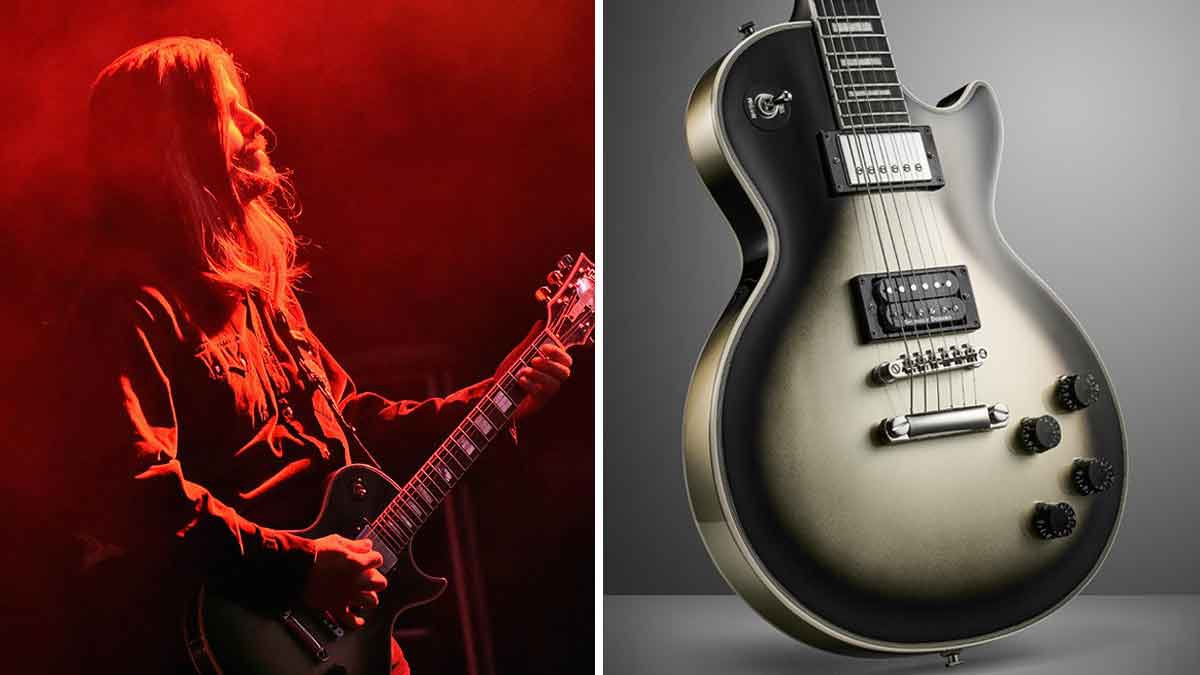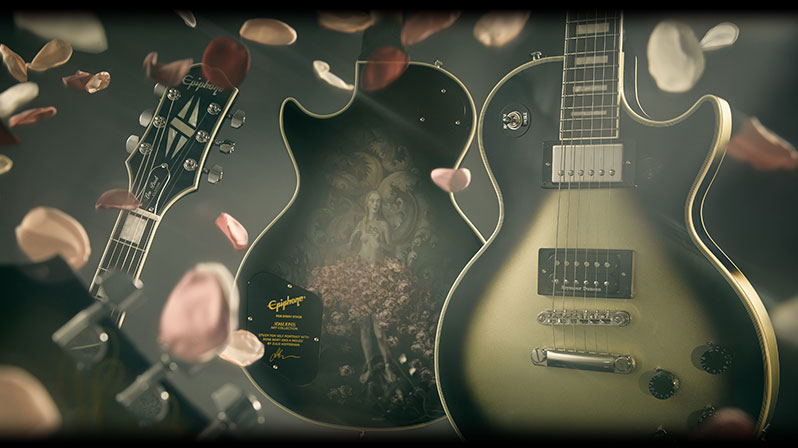“This guitar gives you a piece of me. In fact, I just used one of the Epiphones to do some recording, and I’ve played them onstage, too”: Adam Jones discusses the evolution – and future – of his signature 1979 Les Paul Custom
Adam Jones’ collaboration with Gibson and Epiphone brought together the Tool guitarist’s two loves, music and art, with a line of stunning Aged Silverburst LPs. Will we see more in the future? Jones sure hopes so

With its striking silver-to-black (and, due to aging, sometimes green-hued) finish, the Les Paul Silverburst is one of the most distinctive-looking guitars in modern six-string history.
But over the course of the past year, the eye-catching model has become even more unique – seven times over, in fact. The reason? A one-of-a-kind collaboration between Epiphone and Tool six-string sonic adventurist Adam Jones, which has resulted in the Adam Jones Art Collection of electric guitars.
Jones, of course, is the most visible and impassioned proponent of the Silverburst, and in 2020 he teamed up with Gibson on a limited-edition, note-perfect recreation of his Number 1 instrument, a 1979 Les Paul Custom with the distinguishing finish.
This was followed by a U.S. production-line Standard version of the guitar and, soon after, rumors – as well as appetite-whetting online teases – about a coming Epiphone iteration.
When that guitar was finally unveiled in 2022, it was with a host of premium specs that has led many to call it the best Les Paul ever produced under the Epiphone brand name.
But there was another attraction: each release in the Adam Jones Les Paul Custom Art Collection, limited to just 800 examples, featured a unique piece of artwork personally selected by the Tool guitarist, a visual artist who worked on films like Jurassic Park, Batman Returns and Terminator 2: Judgment Day prior to becoming a prog-metal giant.
“The push was, how can we do something that really reflects me?” Jones tells Guitar World. “So I suggested, ‘Why don’t we do art on the back and make something really special?’ And then Cesar [Gueikian, Gibson CEO] said, ‘How about we make a whole line of them?’ I was like, ‘Oh my God, that’d be great,’ and I started making a list of my top choices. And you know, just like with music, I have really eclectic tastes when it comes to art.”
Get The Pick Newsletter
All the latest guitar news, interviews, lessons, reviews, deals and more, direct to your inbox!
Indeed he does. The Adam Jones Les Paul Custom Art Collection launched with “The Veil of Bees” by acclaimed pop-surrealist Mark Ryden. “He just rips his guts out when he paints,” Jones says, “and his thought process and his journey from an idea to the execution is so involved. It was amazing to have him do the first one.”
From there, the Collection, true to Jones’ eclecticism, spotlighted a wide array of selections – fantasy legend Frank Frazetta’s famous The Berserker, originally created for the cover of the paperback novel Conan the Conqueror; contemporary artist (and Jones’ wife) Korin Faught’s bold Sensation; the mesmerizing ANTI-LAOKOON 1965 from late Austrian painter and School of Fantastic Realism co-founder Ernst Fuchs; a second Ryden creation, Queen Bee; and two striking “self-portraits” from American artist Julie Heffernan, who Jones calls “one of my favorite contemporary painters. I own a bunch of her paintings and I’m just obsessed with her. So it was a blessing to work with her and all the artists and their estates. Because these paintings mean so much to me.”
For Jones, incorporating artwork into a signature Les Paul design had special resonance. “Since I was a kid, music and art have been my way out of the wicked world,” he says. “That’s been my safety net.”
The paintings on the backs of these guitars (and, of course, the Antique Silverburst finish on the top) are just one graphic attraction of the new Epiphones. Each example in the Adam Jones Les Paul Custom Art Collection also sports a special back plate commemorating the featured artist and the name of the work, as well as a Korin-designed insignia on the back of the headstock.
And the exceptional visuals are matched by an absolutely spectacular spec sheet. While the Epiphone expression of Jones’ beloved Silverburst is more affordably priced than the two Gibson versions, it is loaded with many of the same premium features, including a mahogany body with a maple top, a three-piece bound maple neck with a Norlin-era volute (and special “Adam Jones Custom Profile”); an ebony fingerboard with block inlays; PosiLock strap buttons and more.

There’s also no shirking in the electronics department, with a reverse-mounted humbucker in the neck – just like Jones’ Number 1 – and a Seymour Duncan Distortion (again, reflecting Jones’ guitar) in the bridge position. It’s a heavy package, both figuratively and literally: the Epiphones themselves, much like first-run Silverbursts, weigh in at well over nine pounds.
“I like a heavier-weight guitar because I use tube amps, I use analog equipment,” Jones says. “So if you plug one of my heavy guitars into my setup, with a pickup that is responsive to that side of things, it sounds great. You get great tone. You get great feedback, but you can still control it. You get everything I love. This guitar gives you a piece of me. In fact, I just used one of the Epiphones to do some recording, and I’ve played them onstage, too.”
He continues, “So I hope we do another seven of these. I hope that, with Gibson and Epiphone, we do all kinds of things together. Because there’s nothing like music. Nothing compares to it. But the closest thing I’ve found is art. They’ve always gone hand-in-hand in my life.” And now, with the Epiphone Adam Jones Les Paul Custom Art Collection, in his guitars as well.
- For more information on the Adam Jones Les Paul Custom Art Collection, head to Epiphone.com.
Rich is the co-author of the best-selling Nöthin' But a Good Time: The Uncensored History of the '80s Hard Rock Explosion. He is also a recording and performing musician, and a former editor of Guitar World magazine and executive editor of Guitar Aficionado magazine. He has authored several additional books, among them Kurt Cobain: Montage of Heck, the companion to the documentary of the same name.
“It was tour, tour, tour. I had this moment where I was like, ‘What do I even want out of music?’”: Yvette Young’s fretboard wizardry was a wake-up call for modern guitar playing – but with her latest pivot, she’s making music to help emo kids go to sleep
“There are people who think it makes a big difference to the sound. Stevie always sounded the same whether it was rosewood or maple”: Jimmie Vaughan says your fretboard choice doesn’t matter – and SRV is his proof








![John Mayer and Bob Weir [left] of Dead & Company photographed against a grey background. Mayer wears a blue overshirt and has his signature Silver Sky on his shoulder. Weir wears grey and a bolo tie.](https://cdn.mos.cms.futurecdn.net/C6niSAybzVCHoYcpJ8ZZgE.jpg)

![A black-and-white action shot of Sergeant Thunderhoof perform live: [from left] Mark Sayer, Dan Flitcroft, Jim Camp and Josh Gallop](https://cdn.mos.cms.futurecdn.net/am3UhJbsxAE239XRRZ8zC8.jpg)
